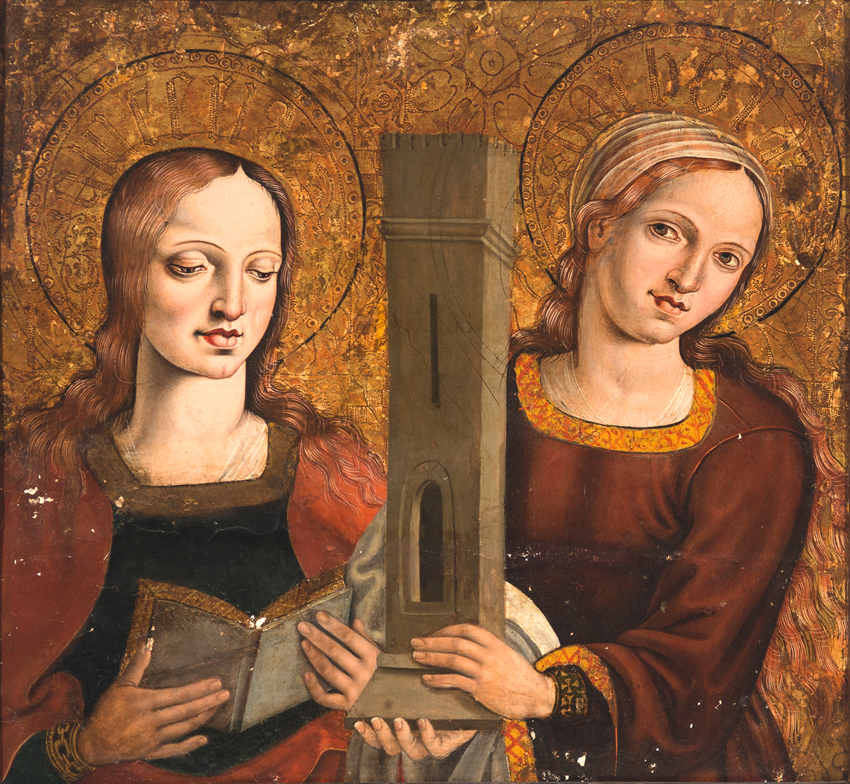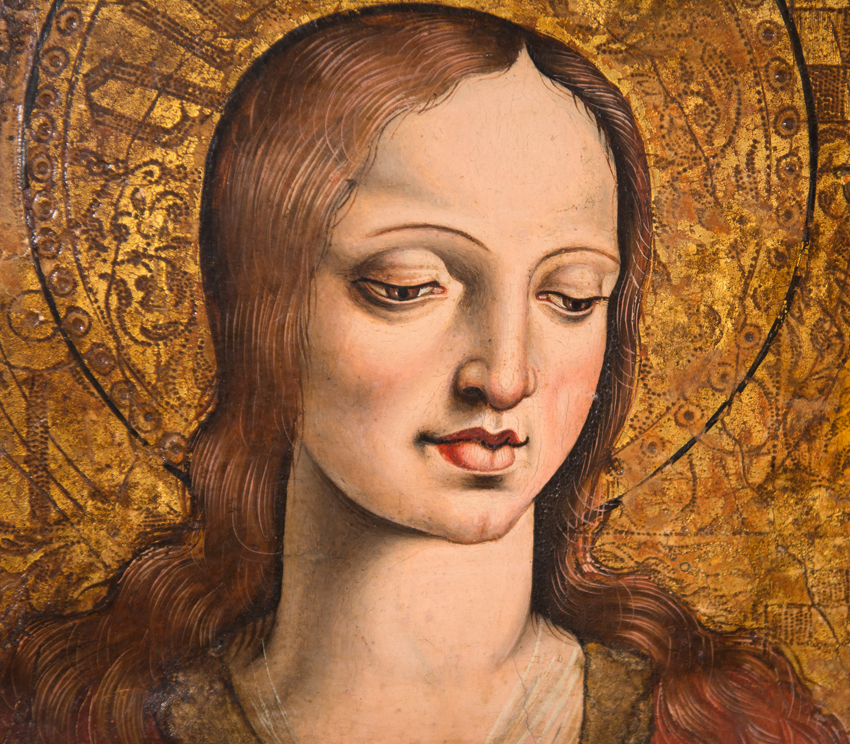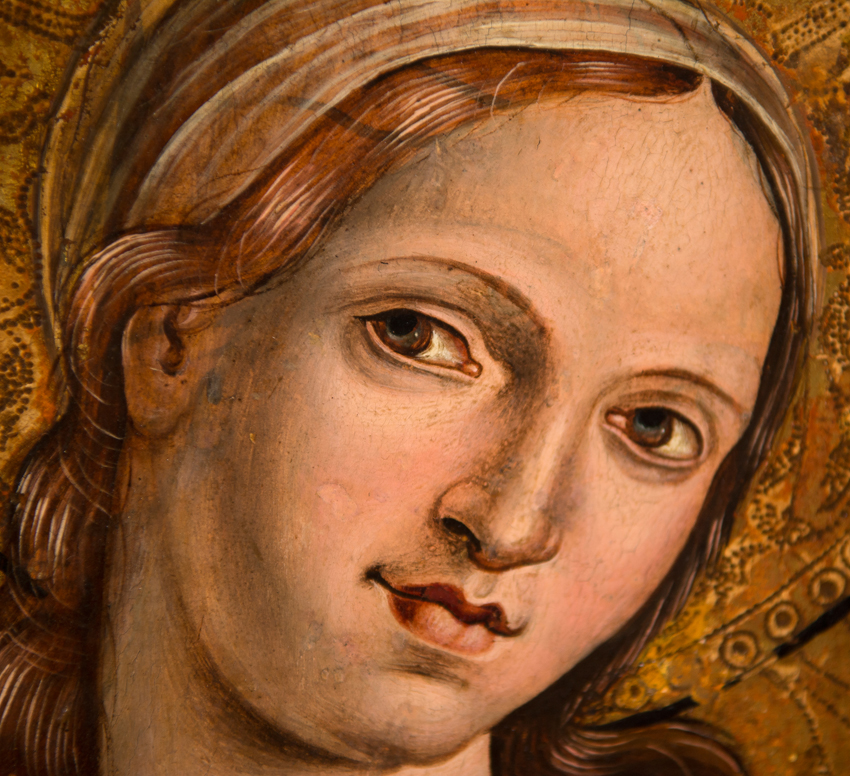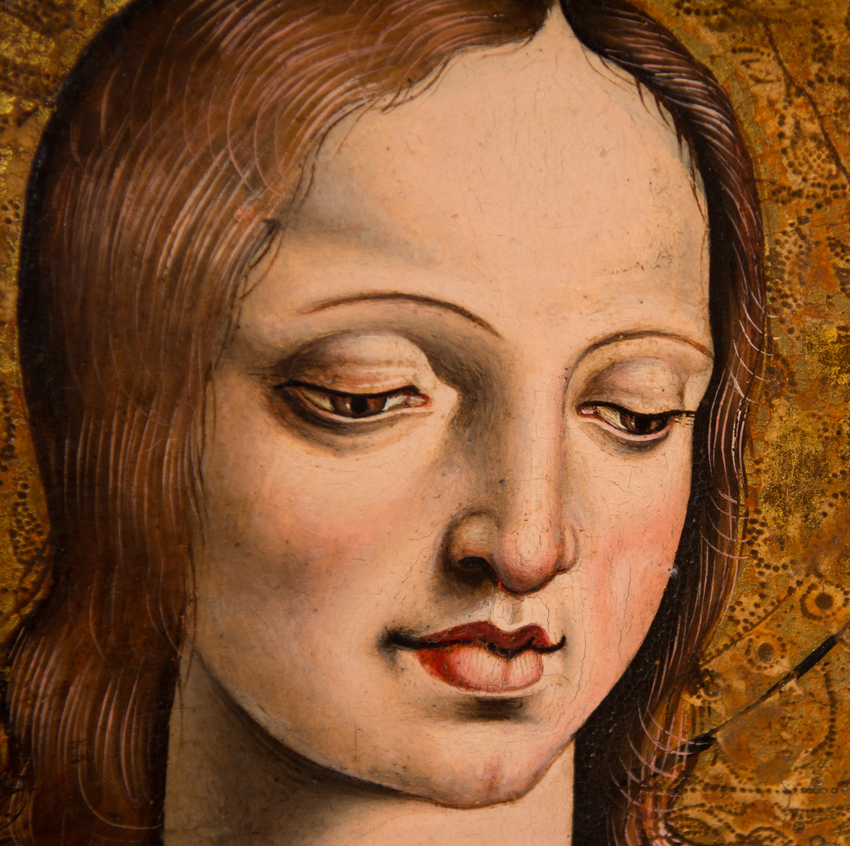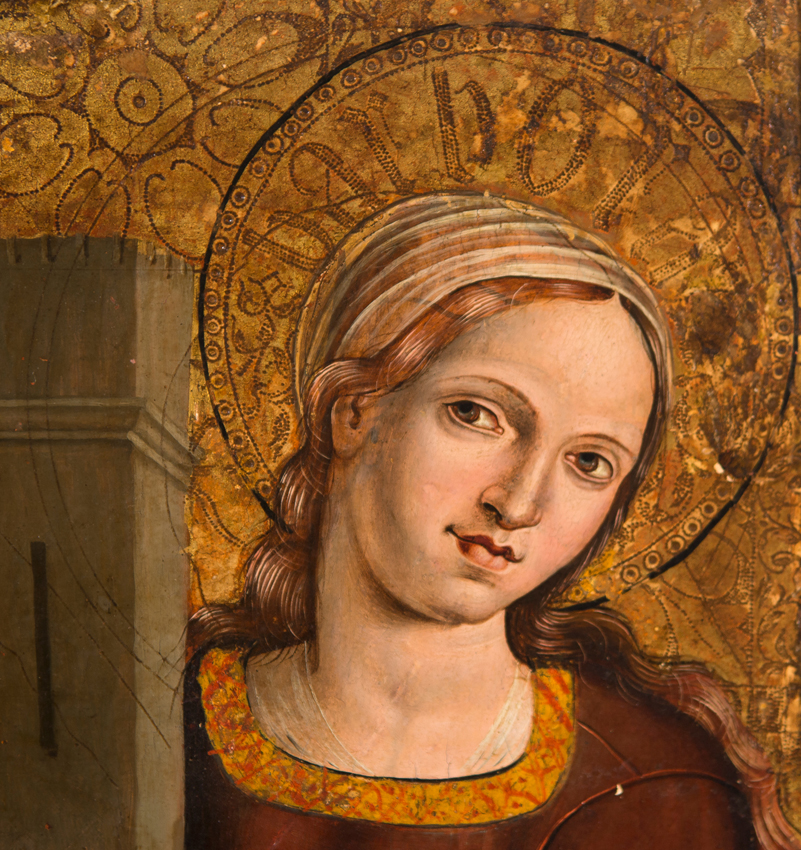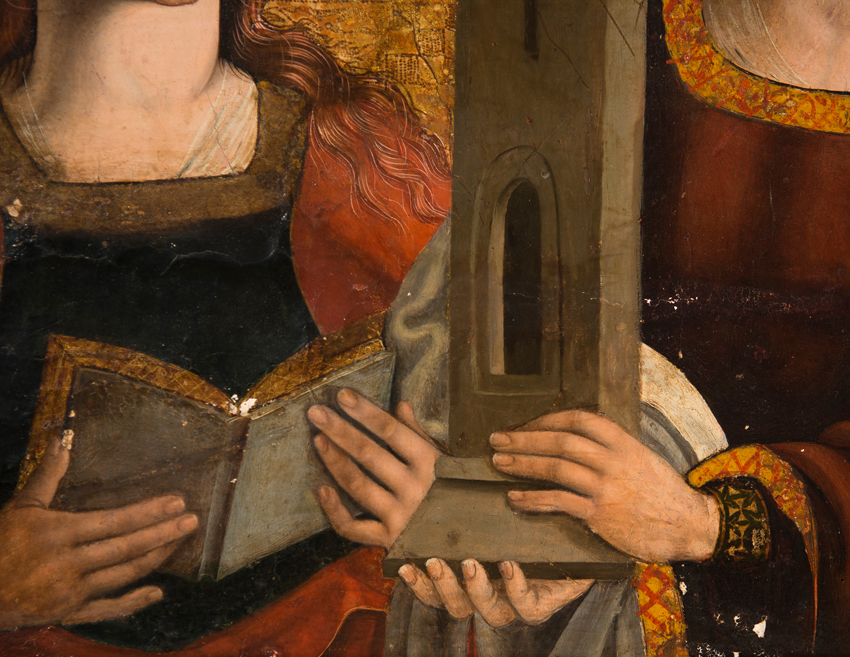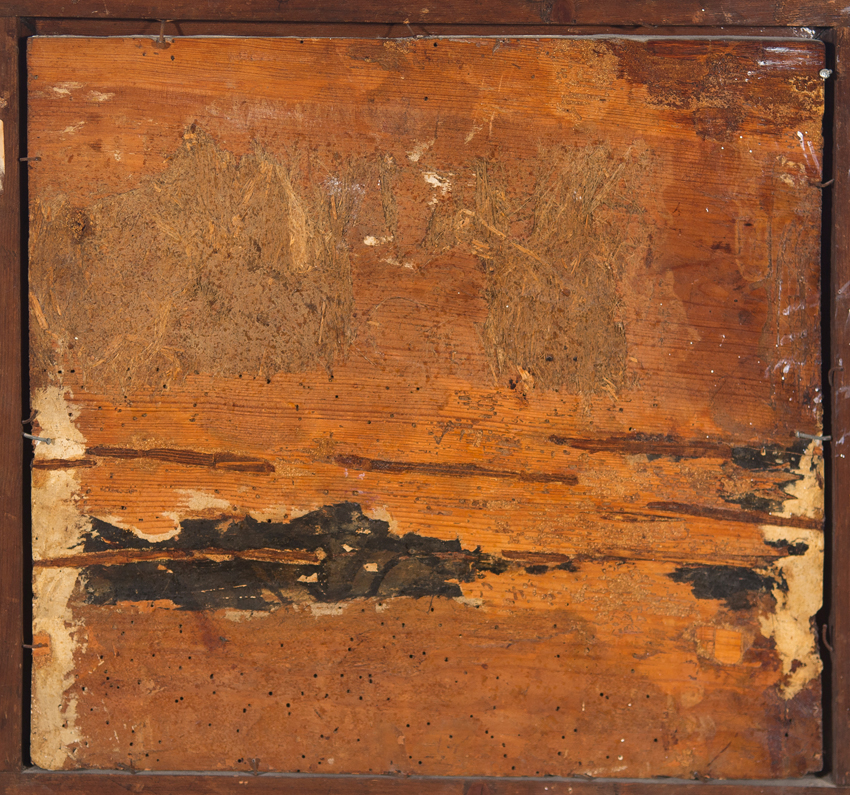6
Castillian School. Circa 1500.
Castillian School. Circa 1500.
"Saint Quiteria and Saint Barbara"
Oil or tempera with gold background on panel. Fragment of an altarpiece, possibly belonging to a predella.
37,5 x 40,5 cm.
Even though we have not been able to recognise the master behind these two saints, his great artistic skill is evident. The faces of both saints are delightful and of unfathomable sweetness.
An exceptional panel that shows the splendour of the Aragonese Renaissance, both in the colour palette, with those shimmering tones on the tunics, as well as in the physiognomy of the models and the flesh tones on their faces and hands in tempera and oil. It is also evident in the perfect gold ground-covered surface for the backdrop, decorated with plant motifs and pointillé, a decorative technique used on gold which consisted of engraving different drawings with small chisel strokes or pricks, thereby pushing down the smooth gilded surface or the stucco mass. There is no doubt as to which saints they are, as they are named on their limbs, Quiteria and Barbara.
Quiteria was alive during the 2nd century A.D. The daughter of a pagan Roman governor, her mother gave her up for adoption, along with her eight siblings, to prevent her honesty from being questioned and to preserve her virginity. According to Christian doctrine, this adoption brought her closer to God. Always linked to prayer, as she appears reading a book of hours, she would eventually meet her parents. Tradition has it that her father, as soon as he learned of her profession of faith, had her head cut off.
Barbara came from Nicomedia, on the Anatolian Peninsula, in the late 3rd and early 4th centuries AD. Highly intelligent, she was the daughter of Diocorus, a wealthy pagan man. Through her reading and studies she questioned her paganism, and because of her religious concerns, she was instructed in the catechism and converted to the Christian faith. Because of her physical beauty, she had no shortage of suitors, but she kept herself a virgin in order to consecrate herself to God. Her father had a tower built to keep her from the eyes of strangers. On one of her father's journeys, she herself ordered the workmen to build a third window (she only had two) to honour the Holy Trinity. She was tortured for her faith, but she did not die as she received help and care from heaven. As she refused to worship the pagan gods, her father finally cut off her head. After decapitating her, her father was struck by lightning and no trace of his body was left.
In the panel, she is shown holding her most characteristic attribute, the tower in which she was imprisoned, at a reduced scale on her hand, as if it were a model. A moulding runs along it and frames it in the manner of the Gothic lines to strengthen a wall or window, in which verticality predominates over horizontality, underlining the mysticism of the figures it contains. This panel would clearly have formed part of the ‘flos sanctorum’ of the lower predellas or side sections of an altarpiece.
Finally, it is interesting to note that marks of the gouge can still be seen on the back of the boards which are assembled horizontally and which form the panel, and the remains of rabbit glue dissolved in water as a grout can be seen, erasing imperfections and smoothing out the pine boards, the most advanced material used at that time for this type of work.
Castillian School. Circa 1500.
"Saint Quiteria and Saint Barbara"
Oil or tempera with gold background on panel. Fragment of an altarpiece, possibly belonging to a predella.
37,5 x 40,5 cm.
Even though we have not been able to recognise the master behind these two saints, his great artistic skill is evident. The faces of both saints are delightful and of unfathomable sweetness.
An exceptional panel that shows the splendour of the Aragonese Renaissance, both in the colour palette, with those shimmering tones on the tunics, as well as in the physiognomy of the models and the flesh tones on their faces and hands in tempera and oil. It is also evident in the perfect gold ground-covered surface for the backdrop, decorated with plant motifs and pointillé, a decorative technique used on gold which consisted of engraving different drawings with small chisel strokes or pricks, thereby pushing down the smooth gilded surface or the stucco mass. There is no doubt as to which saints they are, as they are named on their limbs, Quiteria and Barbara.
Quiteria was alive during the 2nd century A.D. The daughter of a pagan Roman governor, her mother gave her up for adoption, along with her eight siblings, to prevent her honesty from being questioned and to preserve her virginity. According to Christian doctrine, this adoption brought her closer to God. Always linked to prayer, as she appears reading a book of hours, she would eventually meet her parents. Tradition has it that her father, as soon as he learned of her profession of faith, had her head cut off.
Barbara came from Nicomedia, on the Anatolian Peninsula, in the late 3rd and early 4th centuries AD. Highly intelligent, she was the daughter of Diocorus, a wealthy pagan man. Through her reading and studies she questioned her paganism, and because of her religious concerns, she was instructed in the catechism and converted to the Christian faith. Because of her physical beauty, she had no shortage of suitors, but she kept herself a virgin in order to consecrate herself to God. Her father had a tower built to keep her from the eyes of strangers. On one of her father's journeys, she herself ordered the workmen to build a third window (she only had two) to honour the Holy Trinity. She was tortured for her faith, but she did not die as she received help and care from heaven. As she refused to worship the pagan gods, her father finally cut off her head. After decapitating her, her father was struck by lightning and no trace of his body was left.
In the panel, she is shown holding her most characteristic attribute, the tower in which she was imprisoned, at a reduced scale on her hand, as if it were a model. A moulding runs along it and frames it in the manner of the Gothic lines to strengthen a wall or window, in which verticality predominates over horizontality, underlining the mysticism of the figures it contains. This panel would clearly have formed part of the ‘flos sanctorum’ of the lower predellas or side sections of an altarpiece.
Finally, it is interesting to note that marks of the gouge can still be seen on the back of the boards which are assembled horizontally and which form the panel, and the remains of rabbit glue dissolved in water as a grout can be seen, erasing imperfections and smoothing out the pine boards, the most advanced material used at that time for this type of work.
Allegories, Legends and Holinesses
Sale Date(s)
Venue Address
General delivery information available from the auctioneer
The purchase price includes the delivery of the lots in the venue of the auction. Transporting to other destinations is at the own risk of the client. The customer must contact "LST", to give the corresponding instructions for such transporting. "LST" is not responsible for the packaging or any accident incurred during transportation.
Important Information
For buyer’s premium and VAT please check particular lot.
Zu Aufgeld und Mehrwertsteuer prüfen Sie bitte das jeweilige Los.
Terms & Conditions
CONDITIONS OF THE AUCTION:
I. REGISTRATION. To bid in the room customers must register at the beginning, filling out a form and picking a number that will identify them during the auction. Customers may be required to register in bank references or other guarantee system and if they do not prove the solvency "LST" will not accept bids and award the auction.
II. WRITTEN BIDS. "LST" will accept written bids, which will be formalized in the form provided by the room until the day before the auction. In such auctions, the room will bid in name of the client until the maximum stated in the offer and always at the lowest possible price. If there are two or more bids for the same amount, the one placed first will have the priority. Written bids received in advance, will have priority on the day of the auction.
III. TELEPHONE BIDS. "LST" will allow telephone bids, if interested people contact "LST" days before the auction providing personal data, ID card and the phone number which will be used by the staff of "LST" to call at the time of the auction. The buyer, within all the legal rights is making an offer for the asking price, when applies for telephone bid. "LST" will not take responsibility for any technical defects beyond its control, which may prevent to contact successfully the bidder during the auction.
IV. AUCTIONEER. The auction will be conducted by an auctioneer, director of the auction will be judge and arbitrator of it with full authority in its development, will award the lots to the highest bidder and is able to settle any controversy concerning lots sale, reject bids, divide lots or group them and remover objects from the room. Will be able to, if it is deemed suitable, not accept bids on the auction. His decision will be unappealable.
V. SALE OF LOTS. The lots are awarded to the highest bidder. Once the auctioneer blows the hammer, the buyer becomes responsible of the lot purchased, exempting "LST" of liability to for any damage and / or accidents that may occur. No refunds of lots.
VI. STARTING PRICE. The amount shown in the catalogue as the starting price for each lot will be, as a rule, the minimum selling price, except for exceptional cases where a reservation may be agreed upon with the seller or it set discretionary by the room.
VII. SCALE OF BIDS. The bids are set according to the following scale:
From 50.-€ to 200.-€…………………………………………..at 10.-€
From 200.-€ to 500.-€…………………………………… …25 in 25.-€
From 500.-€ to 1.000.-€………………………………..…..….50 in 50.-€
From 1.000.-€ to 2.000.-€………………………………..…100 in 100.-€
From 2.000.-€ to 5.000.-€……………………………….….250 in 250.-€
From 5.000.-€ to 10.000.-€…………………………………500 in 500.-€
From 10.000.-€ to 20.000.-€……………………………1.000 in 1.000.-€
From 20.000.-€ to 50.000.-€……………………………2.500 in 2.500.-€
From 50.000.-€ to 100.000.-€…………………………..5.000 in 5.000.-€
From 100.000.-€ to 100.000.-€………………………10.000 in 10.000.-€
From 200.000.-€ to 200.000.-€………………………25.000 in 25.000.-€
From 500.000.-€ to 500.000.-€………………………50.000 in 50.000.-€
VIII. RIGHT OF ADMISION. "LST" reserves the right to admission to the auction room and to reject, at its judgment, any purchase order, from clients whose solvency is not duly proved as well as not to sale auctions.
IX. SALE PRICES. The successful bidder of one or more lots must pay "LST" the final sale price achieves at auction, plus the 24,5 % plus 21% VAT on the commission, at total 29,64% on Hammer Price.
X. CATALOG DATA. The catalogue data are obtained in order to careful research and advice, however, any responsibility is afforded about its accuracy. The lots will be auctioned in the state in which they are, not accepting any claims in restorations, breakage, damage, imperfections and, even description or numbering mistakes in the catalogue, in case of it, being the burden of the buyers to make sure before the auction that the description matches with their personal opinion about respective lot. The exhibition of the lots is intended to allow a perfect review and study of them.
XI. PAYMENT AND REMOVAL OF LOTS. Payment and removal of the lots will be held no later than five days following the auction. After this period expire without having the buyer removed the lot or lots purchases, it will accrue an expense of custody of 6 euros per day on each lot.
15 days after the auction without having the buyer paid and removes the sold lots, "LST" will inform the seller and there will begin judicial proceeding in order to obtain payment. The delay in payment by the purchaser of his/her sold lots will carry an interest increase at a rate of 1,5% per month.
XII. DELIVERY OF LOTS. The purchase price includes the delivery of the lots in the venue of the auction. Transporting to other destinations is at the own risk of the client. The customer must contact "LST", to give the corresponding instructions for such transporting. "LST" is not responsible for the packaging or any accident incurred during transportation.
XIII. RIGHT OF FIRT REFUSAL AND REPURCHASE. "LST" in order to article 38 of "Ley 16/1985 de 25 Junio del Patrimonio Histórico Español" (BOE. 155 June 29, 1985), will notify in advance to the Ministry of Culture, the content of their catalogues. Concerning the lots subject to the legislation referred to in the preceding paragraph, the Administration may exercise the rights of first refusal and repurchase according to the law. "LST" will watch over the protection of Artistic, Historical and Bibliographical Heritage of Spain. For customers out of European Community, a tax for export is required by the Administration.
XIV. VALUE ADDED TAX (I.V.A). This tax will be accrued on commissions of "LST" for buyers, using the rates prevailing on the date of the auction.
XV. DATA PROTECTION. In order to the "Ley 15/1999 de 13 de Diciembre, de Protección de Datos de Carácter Personal", the client authorize "LST", the inclusion of their data in a customer file, and for the promotion by "LST" of the objects at all times the rights of access, rectification or deletion of personal data by sending the appropriate request to the following address: LA SUITE SUBASTAS, C/ Conde Salvatierra, 8, 08006. Barcelona.
XVI. EXPRESS LEGAL JURISDICTION. These Conditions are governed by and interpreted in accordance with the rules of Spanish law. The mere act of participating in the auction as seller, buyer or bidder, implies acceptance of these Terms and Conditions.
Sales operations are understood to be held at the registered office of "LST", C/ Conde de Salvatierra, 8, 08006. Any dispute shall be taken to the competent courts of Barcelona, expressly waiving any other jurisdiction, in accordance with Article 55 of the "Ley de Enjuiciamiento Civil".


















